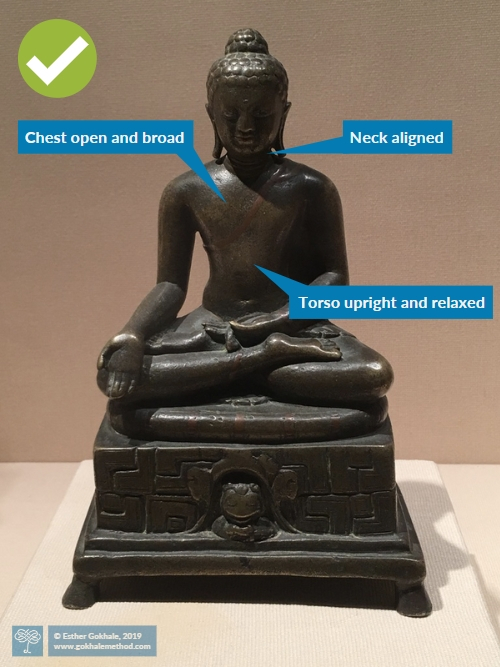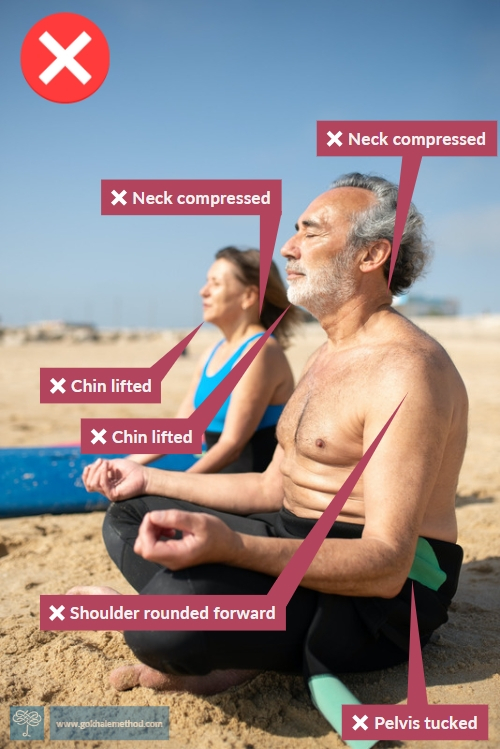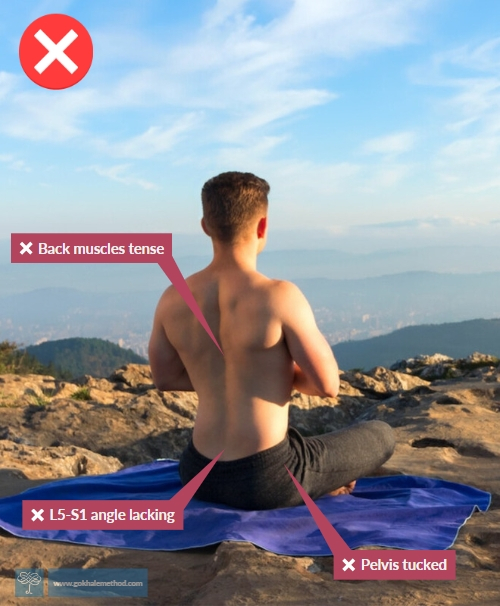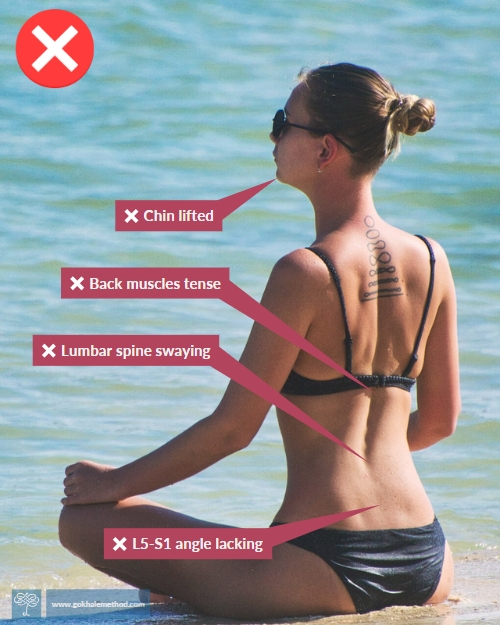Posture Tips for Meditators
It has been over 60 years since Eastern schools of meditation became widely known in the U.S. and Europe, and meditation became widely practiced, with over 14% of Americans having meditated at least once. If we include those practicing mindfulness techniques, using meditation apps, and attending yoga classes with a meditation component, this figure goes far higher.
The effects of sitting in meditation
The potential benefits of meditation are well known, and include a calmer, clearer mind, lower levels of stress, better sleep, improved relationships with others, and better mental health.
From a posture perspective, whether you sit in meditation regularly or are just getting started, you want the experience to be as healthy for your body as it is for your mind.
Tradition and seated meditation

This North Indian Buddha figure shows healthy form. He has a well-stacked spine, open shoulders, and an elongated neck. (Post Gupta period, 7th–8th century C.E..)
Westerners often try to be “authentic” in their meditation by sitting cross-legged on the floor, as is portrayed in most traditions. This is particularly difficult for people who have not grown up regularly sitting this way. It may be that practitioners manage to cross their legs, but then their pelvis is not able to tip forward. Their hip joints will not have developed in childhood and ossified in their teens for unaided cross-legged sitting to be a truly comfortable and biomechanically available option.
Common problems in upright seated meditation
With the pelvis tucked, meditators have two options, both of them unhealthy:
- Sitting on their tail bones in a relaxed but slumped position, which will put their spines into a C-shape that overstretches the ligaments of the SI joints and spine, and compresses the spinal discs and nerves. Such collapsed posture restricts the lungs, stomach, and other organs. It also deconditions the deep inner corset muscles that are there to regulate spinal alignment “in the background” during healthy sitting.
- Sitting tucked but holding themselves upright by tensing the back muscles. Many meditators and yoga practitioners are so familiar with this effortful solution to being upright that they don’t realize that they are doing it, or recognize it as poor posture.
It takes freedom in the hip socket to allow the pelvis a good range of motion, rotating forward (anteverting) around the head of the femurs—then the spine can articulate at L5-S1 to stack upright and the back muscles can relax. You can read more about healthy pelvic anteversion here.

The man’s notably tucked pelvis is sending his spine into a C-shape. Their upper backs are rounded, compressing the base of the neck and lifting the chin to face forward. Pexels

This man is holding himself up with tension in his back muscles. He can learn to antevert his pelvis to find its natural L5-S1 angle, allowing his back to be upright and relaxed. To get there we recommend a suitable wedge along with some posture know-how. Pexels

This woman is getting some anteverting benefit from the slope of the beach, but is used to swaying her lumbar area rather than having a healthy angle lower down at L5-S1. Unsplash

This Chinese Buddha figure shows surprisingly slumped posture. Note the forward head, absence of a stacked spine, and tucked pelvis. With a tucked pelvis slumping is the only relaxed option for sitting.
The hunched figure above is the oldest Chinese Buddha figure that has survived into modern times. The inscription on its base dates it to 338 C.E., 500 years after Buddhism came to China from India. Why does the hunched posture of the Chinese figure compare so poorly with the Indian figure (top)? It is reasonable to suppose that while crossed legged sitting was the norm in India, a warm country where much of the population sits on the floor to gather, eat, socialize, and more, in China, with its generally cooler climate, sitting crossed legged was consciously adopted for meditation but was not a widely used sitting position.

Here I am stacksitting on the Gokhale™ Pain-Free Chair—my pelvis is anteverted so my spine stacks upright and relaxed, with a healthy angle at L5-S1. This way of sitting enables you to sit in meditation comfortably for prolonged periods if required, and to breathe well. Like all students on the path of postural improvement, I am a work in progress. . .
Appropriate furniture, props, and seating solutions
Most Zen and yoga centers in the West have become more enlightened about the difficulty many people have in sitting on the floor, providing chairs, meditation stools, and cushions for meditators’ comfort. Some more recently established schools, such as Transcendental Meditation, have always encouraged practitioners to use chairs and sofas rather than wrangle with the difficulties of sitting on the floor and working through the resultant aches and pains.
That said, seeking comfort and back support from soft and poorly contoured modern furniture can also promote slumping, or lead to problematic remedies such as using lumbar cushions which sway the back. You can read more on finding a healthy back rest here, as well as about gentle traction from our Stretchsit® Cushion.
Traditional and potentially effective solutions to help meditators sit without a backrest include the Japanese Zafu cushion, a high, round cushion that can help the thighs and pelvis to angle down, and a low wooden meditation stool used in a kneeling position. The Gokhale™ Wedge is a modern solution to support stacksitting. In all cases, it is important that the practitioner knows how to anchor their rib cage to resist any tendency to sway, and how to find articulation at the lower L5-S1 junction.

Four props for healthy sitting (top left to bottom right): a Japanese Zafu cushion, the Gokhale™ Wedge, a kneeling meditation stool, and the Gokhale Stretchsit® Cushion
Healthy sitting makes for healthy breathing
Given that controlled or mindful breathing is part of many meditation practices, it’s surprising how little attention is given to the link between breathing well and sitting well.
Some meditation traditions have mimicked teachers and icons with slumped posture, and teach that the associated abdominal breathing is part and parcel of spiritual practice. This type of breathing, however, results in a soft, expanded belly with low muscle tone, an underdeveloped chest, and inadequate use of the diaphragm and lungs.
Equally problematic is tensing the back to remain upright, which tightens the erector spinae muscles and restricts the diaphragm and ribs at the back. It takes stacksitting with a J-spine to let the breath work its magic—bringing a natural massage to your spine, better circulation, and length, strength, and flexibility to the musculoskeletal parts of the torso.
Chop wood, carry water, preserve your posture
There is a traditional Zen Buddhist koan (puzzle/story):
The novice says to the master, "What does one do before enlightenment?"
"Chop wood. Carry water," replies the master.
The novice asks, "What, then, does one do after enlightenment?"
"Chop wood. Carry water."

Chopping wood and carrying is part of everyday life for millions of people in traditional communities—and it is done with healthy posture.
Of course there are various interpretations of this koan, including that the most pedestrian of activities are also the most sacred. From a posture teacher perspective, the koan reminds us that in the pursuit of spiritual (or mental) development, we should continue to engage with the physical foundations of life. Not only are the body, mind and spirit intertwined, but a healthy body can also help support our other endeavors.
Breaking free from old habits
Meditators often come to work with us because they are frustrated by their pain and struggle to be comfortable. In our experience, though meditators are extensively trained in matters of the mind, the training of the body lags behind. Our teachers have expertise in identifying and solving systemic postural errors in meditation and other activities, and are ready to support you on your meditation and life journey.
Best next action steps for newcomers
If you would like insight on your posture, consider scheduling an Initial Consultation, online, or in person.
You can sign up below to join one of our upcoming FREE Online Workshops.

Comments
Thank you for this helpful
Thank you for this helpful post on sitting properly for meditation. I would also appreciate a side view of good sitting posture on a meditation cushion - there are 4 wrong side views and one correct front view pictured. My pelvis is tipped forward, using a zafu that is filed with buckwheat hulls so is malleable versus the more rigid Kapok filled ones (as in your photo). Once i sit down, i do a shoulder roll and rib anchor plus park my chin and elongate my neck. It's very comfortable and seems in line with the Gokhale method but I would appreciate a photo from the side. Thanks so much!
I do a standing meditation
I do a standing meditation practice. This allows my body to be in Gokhale posture while I have a mindful experience.
I sit cross legged on the
I sit cross legged on the sofa with a cushion to support the J-curve and allow me to relax the back.
The Foundations course helped
The Foundations course helped me immensely with my meditation posture, reduced associated pain and increased concentration. There are still issues that I am working on using Foundation principles.
Add New Comment
Login to add commment
Login